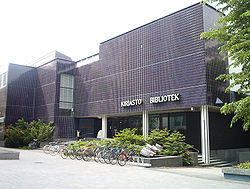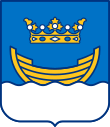Helsinki City Library
| Helsinki City Library | |
|---|---|
| Helsingin kaupunginkirjasto Helsingfors stadsbibliotek | |
 Pasila Library, the main library in the Helsinki City Library system | |
 | |
| 60°12′2.99″N 24°56′8.88″E / 60.2008306°N 24.9358000°E (Pasila Library) | |
| Location | Finland |
| Type | Public library |
| Established | 7 October 1860 |
| Branches | 37 + 2 bookmobiles |
| Collection | |
| Size | 1.81 million (1.57 million books)[1] |
| Access and use | |
| Circulation | 7.28 million (2020)[1] |
| Other information | |
| Budget | €39,362,374 (2020)[1] |
| Director | Katri Vänttinen (2017 – ) |
| Employees | 457[1] |
| Affiliation | HelMet |
| Website | www |
| References: "Suomen yleisten kirjastojen tilastot" [Finnish Public Library Statistics] (in Finnish). 2020. Retrieved 2 October 2021. | |
Helsinki City Library (Finnish: Helsingin Kaupunginkirjasto, until 1910 Helsinki People's Library) is the largest public library in Finland. Owned by the City of Helsinki, the library has 37 branches and a collection of about 1.56 million books.[1] The City Library is part of the Helsinki Metropolitan Area Libraries network.
History
[edit]Helsinki People's Library (1860–1876)
[edit]On 7 October 1860, the Helsinki People's Library (Finnish: Helsingin kansankirjasto) opened at Hallituskatu 11, the current location of the University of Helsinki's Porthania building. Funding for the library was raised by the Helsinki Women's Association with the goal of educating Helsinki's residents and provide them with constructive leisure activities. The effort was led by teacher Helene Simelius, author Zacharias Topelius, and Bishop Frans Ludvig Schauman.[2]
In its first year of operation, the library held about 400 to 500 books (primarily in Swedish) and circulated about 1,700 loans. Borrowing books was free, which allowed the library to enjoy many patrons, but at the same time it caused financial problems. The library had to move from one rented location to another every couple of years, and the volunteer librarians also changed frequently. Due to its lack of funding, the library began charging patrons in 1867, and in 1871 it began to receive an annual subsidy from the City of Helsinki. Thanks to the city's support, the library's finances stabilized, and it could hire a professional staff.
Five years later, the library's board offered to transfer the library to the city. On 28 March 1876, the City Council of Helsinki formally agreed to take over operation of the library. As the library already operated with city funding, there were no major changes in operations. At the time of the transfer to the city, the People's Library's annual circulation was about 15,000 loans and its collections included more than 2,000 books.
From People's Library to City Library (1876–1945)
[edit]
With the city now in control of the library, it began planning for a dedicated building. In 1877, Helsingin Anniskeluyhtiö (Helsinki Liquor Co.), which held a monopoly on alcohol sales in the city on the condition it devoted its profits to benefiting city workers, donated 61,405.29 Finnish markka (€368,659.34 in 2020)[3] for the library to secure its own building. A plot of land was acquired on the corner of Rikhardinkatu and Korkeavuorenkatu in the Kaartinkaupunki district, and architect Theodor Höijer was contracted to design the building. The library moved to its new home in autumn 1882.[4]
With the Rikhardinkatu Library complete, the city began developing branch libraries. In 1898–1899, branch libraries were established in Töölö and Punavuori, and the private Sörnäinen People's Library was taken over by the city. Additional branches opened in Vallila in 1908 and Käpylä in 1926. Most of these branches operated from rented locations, except for the Kallio Library, which received a Karl Hård af Segerstad-building in 1912.
In 1910, the library adopted a new charter as the "Helsinki City Library." As the People's Library, the focus was on the needs of working populace, but the City Library was required to serve all residents regardless of social class.
At the turn of the 19th and 20th centuries, the library's annual circulation volume exceeded 200,000 loans. In 1912, there was a shift to free borrowing and the circulation rate quickly rose to 500,000. In 1930, the library achieved 1 million loans for the first time. To handle the library's growing collection and activity, the Rikhardinkatu Library was expanded in 1922, and through the 1930s the city sought to build a new main library; however, the outbreak of World War II in 1939 mooted those efforts.
Growing with Helsinki (1945–)
[edit]After World War II, the establishment of the Grand Regional Association of Helsinki brought a great expansion to the City Library. It absorbed the libraries of the former municipalities of Haaga, Huopalahti, Oulunkylä, and Kulosaari, along with libraries in the Helsinki Rural District. In total a dozen additional libraries were added to City Library's five branches and one main location. In 1953, it opened a music library and in 1966 it began operating a bookmobile. In 1986, the library finally completed construction of a new main library in Eastern Pasila. In 2019, the Helsinki City Library registered more than 9 million visitors to its branches.[4]
In 1981, the Helsinki City Library began serving as the national central library for Finnish public libraries, and in 2018 it gained responsibility for overseeing development of libraries nationwide under the 2016 Public Libraries Act.[5]
About the City Library
[edit]As of 2020,[update] the Helsinki Library has 36 branches and one main location. It also operates two bookmobiles and four "patient libraries" (potilaskirjasto) in medical facilities.[1]
Special collections
[edit]The most significant collection in the Helsinki City Library is the Helsinki Collection of material related to the growth of the city. The Kallio Library has a Detective Library donated by the Finnish Whodunnit Society. The Rikhardinkatu Library has a British Collection of English-language literature and an artist's book collection. Branch libraries also contain material about their local area.
Locations
[edit]Closed branches
[edit]| Library name | Year closed | Address | Coordinates | Image |
|---|---|---|---|---|
| Library 10 | 2018 | Elielinaukio 2G, 00100 Helsinki | 60°10′18″N 24°56′17″E / 60.17166°N 24.93815°E | 
|
| Kirjakaapeli | 2005 | Lasipalatsi, Mannerheimintie 22–24, 00100 Helsinki | 60°10′13″N 24°56′13″E / 60.17035°N 24.93699°E | |
| Kulosaari Library | 2009 | Kyösti Kallion tie 1, 00570 Helsinki | 60°11′08″N 25°00′33″E / 60.18569°N 25.00913°E | |
| Punavuori Library | 2004 | Bulevardi 42, 00120 Helsinki | 60°09′44″N 24°55′55″E / 60.16236°N 24.93195°E | |
| Ruoholahti Children's Library | 2015 | Santakatu 6, 00180 Helsinki | 60°09′45″N 24°55′10″E / 60.16259°N 24.91934°E |
References
[edit]- ^ Jump up to: a b c d e f "Suomen yleisten kirjastojen tilastot" [Finnish Public Library Statistics] (in Finnish). 2020. Retrieved 2 October 2021.
- ^ Hirn, Sven (1998). Kansankirjastosta kaupunginkirjastoksi: Helsingin kaupunginkirjasto 1860–1940 [From the People's Library to the City Library. Helsinki City Library 1860–1940] (in Finnish). Helsinki: Helsingin Kaupunginkirjasto. ISBN 951-718-177-9. OCLC 56835899.
- ^ "Value of money converter". Statistics Finland. Retrieved 2 October 2021.
- ^ Jump up to: a b "160-year-old Helsinki City Library keeps up with its time, reaches residents with versatile services". Oodi. 10 May 2020. Retrieved 2 October 2021.
- ^ Opetus- ja kulttuuriministeriön asetus yleisistä kirjastoista [Decree of the Ministry of Education and Culture on public libraries] (Decree 660/2017) (in Finnish). 2 October 2017.
Further reading
[edit]- Hirn, Sven (1998). Kansankirjastosta kaupunginkirjastoksi: Helsingin kaupunginkirjasto 1860–1940 [From the People's Library to the City Library. Helsinki City Library 1860–1940] (in Finnish). Helsinki: Helsingin Kaupunginkirjasto. ISBN 951-718-177-9. OCLC 56835899.
- Koski, Pirkko (1985). Tiedon tuntijat: Suomen Kirjastoseura 1910-1985 [Knowledgeable. Finnish Library Society 1910-1985] (in Finnish). Helsinki: Kirjastoseura. ISBN 951-9025-40-5. OCLC 13007431.
- Mäkinen, Ilkka (1999). Kirjastojen vuosisata: yleiset kirjastot Suomessa 1900-luvulla [A Century of Libraries: Public Libraries in Finland in the 20th Century] (in Finnish). Helsinki: BTJ Kirjastopalvelu. ISBN 951-692-470-0. OCLC 236020480.
- Närhi, Mauri K. (1963). Lukuseurasta kansankirjastoon: Helsingin kirjastotoimintaa 1800-luvulla [From the Reading Society to the Public Library: Helsinki's Library Activities in the 19th Century] (in Finnish). Helsinki: Helsingin kaupunki.
- Vatanen, Pirjo (2002). Sääty-yhteiskunnan kirjastosta kansalaisyhteiskunnan kirjastoksi : yleisten kirjastojemme murroskausi 1890-luvulta 1920-luvulle [From the Library of the Estate Society to the Library of Civil Society: The Transition of Our Public Libraries from the 1890s to the 1920s] (in Finnish). Helsinki: Suomalaisen Kirjallisuuden Seura. ISBN 951-746-358-8. OCLC 50280344.




































